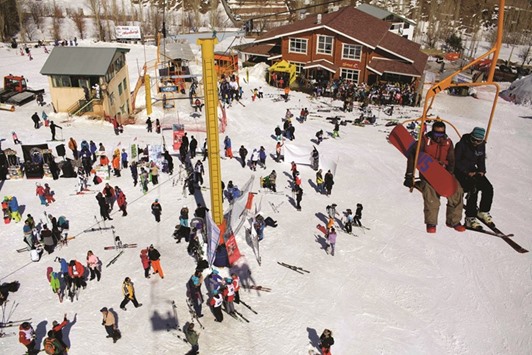Long seen as a destination strewn with shortcomings, Iran is making a fresh pitch for tourists, with the recent lifting of economic sanctions providing an opportunity to cash in.
The tourism industry has been overlooked by successive governments in Tehran but the deal Iran struck with world powers over its nuclear programme last summer could change that.
Along with nine companions including Americans and Germans, China-based Frenchman Yannick Lequelenec said he aims to make “one unique journey” every year. For 2016, he chose Iran.
“My family told me I was crazy, but people have been welcoming and very friendly,” he said in Tehran of his one-week trip taken over the Chinese New Year holidays.
Tourists, and the healthy revenues they could generate, are among the huge economic changes stemming from the nuclear deal.
Ski resorts, Unesco-listed world heritage sites and deserts combine with cities steeped in Middle Eastern grandeur and tradition.
A tourism push was launched after President Hassan Rouhani came to power in 2013, ending the hardline era of Mahmoud Ahmadinejad during which Iran’s international isolation deepened.
Entry procedures have been simplified, meaning visitors from only 11 countries are not eligible for a visa on arrival.
The US, Britain, Canada and France top the exclusion list but some people will not be put off by the restrictions.
“The first thing we did was to go skiing in Tochal,” said Rachel Punter, a 41-year-old British teacher based in Shanghai who was among Lequelenec’s group.
The ski resort is one of several close to the capital. That outing was followed by trips to Isfahan, Shiraz and Yazd, cities considered much more beautiful and relaxed than Tehran.
Among the popular sites in Isfahan is Imam Square, second in size only to Tiananmen Square in Beijing, but with water fountains and impressive architecture, the Iranian site is much more attractive.
For Rouhani, tourism offers a way to offset falling oil prices that have slashed government income. The goal is 20mn tourists annually by 2025 which would provide $30bn a year, a fivefold increase in current revenues from foreign visitors.
It comes as tourists shun many parts of the Middle East because of war and a recent wave of militant attacks in countries including Egypt and Tunisia. International credit and debit cards still do not work in Iran, but arriving with foreign currency and converting it into a large bundle of local rial notes does not seem a handicap.
There have been 4.16mn visitors in the first nine months of the Iranian year, which started in March 2015, up 5% from a year earlier, according to the tourism ministry.
Two thirds of them come from neighbouring countries, such as Iraq, Azerbaijan, Armenia and Afghanistan or Pakistan, predominantly religious pilgrims visiting the holy Shia cities of Mashhad, northeast of Tehran, and Qom, south of the capital.
Western tourists currently number only 5% but the trend is upward, according to Ebrahim Pourfaraj, head of Pasargad Tour Agency and president of the Association of Iranian Tour Operators.
“For tourists, the sense of security and peace is very important. The nuclear deal and the trips of President Hassan Rouhani to Italy and France have reinforced this phenomenon,” he said. Those visits underlined Iran’s acceptance and willingness to trade with Europe after the nuclear deal.
But after decades of inadequate investment, facilities and capacity are sparse.
Of the country’s 1,100 hotels, only 130 are four or five star - 400 more would be needed to accommodate 20mn tourists annually.
Azam Ayoubian, owner of the 2001 travel agency in Tehran, also said demand far exceeds supply.
“Compared to last year, we can easily see an increase by a factor of two or three,” she said of enquiries from abroad.
French or English speaking guides are booked up to the end of 2017 and the four or five star hotels in Isfahan, Shiraz and Yazd are sold out months in advance.
The foreign visitors are people who “have travelled the world and want quality holidays,” Ayoubian said. “We can’t just put them in a hotel in which they’d be uncomfortable.”
Iran will have to adapt quickly to make the most of renewed interest. “If the infrastructure existed, we could take 30% more tourists who are not visiting for religious reasons,” Pourfaraj added.

A 2015 file photo of skiers on a ski lift over the Darbandsar ski resort, 60km northeast of Tehran.


